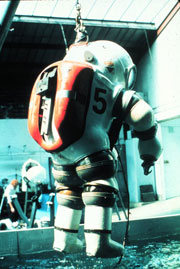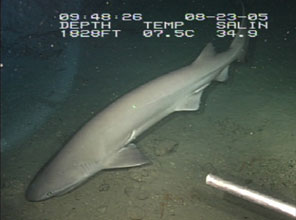|
Home > Ocean > Ocean Zones > Twilight Zone
Understanding Ocean Zones: The Twilight Zone
Also known as the
Mesopelagic zone, this life zone is the midwater range and is noted for very low levels of sunlight
and virtual darkness for human eyes. This layer ranges from 200 meters
to about 800 meters down. The plankton, which occupies the sunlight
layer in profusion and provides a food source for most of the creatures
living in that layer, either directly or indirectly, does not live
in the twilight zone. Plankton needs adequate sunlight to thrive.
The type of foods available to creatures living at these depth tend
to be energy-poor and usually are characterized by detritus and bacteria,
the things that drift down from the sunny creatures teeming and thriving
at the surface. Most of the sea creatures living in this layer have
low-energy tissues and sluggish lifestyles to cope with low food energy,
since no algae can grow. Life here is noticeably sparse, the deeper
you go.
 The hydrostatic pressure in the twilight zone is
much greater and special suits and diving crafts are necessary for
humans to explore this layer of the water column. A highly specialized
diving suit was designed and built for manned diving operations and
exploration of these depths. Called the JIM suit, it is a type of
atmospheric diving suit that creates artificial atmospheric conditions
inside the suit (of 1 atmosphere, the same at sea level) regardless
of the hydrostatic pressure outside the suit. It also protects the
diver inside from the extreme cold temperatures at these depths and
the risk of hypothermia. To date, the deepest dive for a JIM suit The hydrostatic pressure in the twilight zone is
much greater and special suits and diving crafts are necessary for
humans to explore this layer of the water column. A highly specialized
diving suit was designed and built for manned diving operations and
exploration of these depths. Called the JIM suit, it is a type of
atmospheric diving suit that creates artificial atmospheric conditions
inside the suit (of 1 atmosphere, the same at sea level) regardless
of the hydrostatic pressure outside the suit. It also protects the
diver inside from the extreme cold temperatures at these depths and
the risk of hypothermia. To date, the deepest dive for a JIM suit
Imagine yourself inside a JIM suit – it feels
like a personal sized mini-sub. As you look out into the deep, deep
blue water you see that life down here is pretty sparse. Soon, you
see unfolding before your eyes what looks like a light show. One of
the most spectacular and awe-inspiring phenomenon that a human diver
visiting this realm can experience is bioluminescence. Many organisms’
body tissues are capable of emitting their own light – they
glow in the dark. The colors range from blues to greens and even red, as some fish
even emit red light as a form of infrared vision to help them see
their prey in darkness. Although it isn’t completely dark in
the twilight zone, many of the creatures that live in this ocean zone
have developed this highly specialized adaptation for different reasons.
A great many organisms throughout the water column (including those
that live at the ocean surface) are capable of bioluminescence, but
it plays a more critical role in the lives of creatures that exist
in almost complete darkness. For example, some creatures, such as
squid and octopi, emit clouds of glowing ink to evade predators. Others,
such as jellyfish and some bony fish, use light to attract prey. In
a world where sunlight casts just a faint blue glow for brief periods,
organisms have adapted by generating their own light. The next ocean zone is in completedarkness all the time, the midnight zone...

Primitive deep sea six-gill shark
|
|

